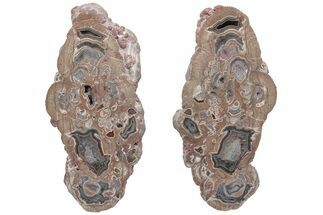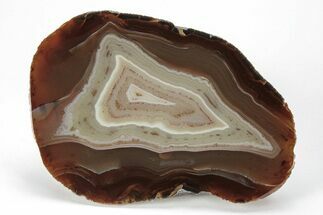This Specimen has been sold.
3.8" Polished Baker Ranch Banded Agate Slice - New Mexico
This is a gorgeous Baker Ranch Banded Agate Slice that was collected from New Mexico. It appears to be the agate center of a Thunderegg where the surrounding rock of the geode was removed. The dark, smoky colors are quite attractive and make for an appealing display.
It comes with an acrylic display stand.
It comes with an acrylic display stand.
Baker Egg agate (also known as Baker Ranch agate) is a type of agate that formed as thundereggs (lithophysae) from a primarily rhyolite-perlite host rock. They are collected from an area southwest of Deming, New Mexico that was formerly known as Baker Ranch. These thundereggs are unique in that they exhibit vibrant coloration typically only found in agate nodules (amygdaloids).
Thundereggs are rarely found in any other color than white, blue or grey-blue, yet Baker Egg Mine produces mixtures of red, yellow, black, white and, in rare cases, green agate. This is due to the unique geologic history of the area, where rhyolitic lava deposits were disrupted by a mixture of geologic forces and the introduction of basaltic and andesitic lava flows over millions of years. These additional lava flows likely provided the minerals necessary for the variety of coloration found in Baker Egg agates (thundereggs).
Thundereggs are rarely found in any other color than white, blue or grey-blue, yet Baker Egg Mine produces mixtures of red, yellow, black, white and, in rare cases, green agate. This is due to the unique geologic history of the area, where rhyolitic lava deposits were disrupted by a mixture of geologic forces and the introduction of basaltic and andesitic lava flows over millions of years. These additional lava flows likely provided the minerals necessary for the variety of coloration found in Baker Egg agates (thundereggs).
About Agate
Agate is a variety of microcrystalline quartz (chalcedony) that displays translucence and, in some cases, banding. Agate primarily forms when silica-rich fluids fill pockets within rocks and/or fossils, depositing the silica along the walls of the rock. This process can result in banding patterns, as the compositions and impurities of these depositing fluids change over time. These banding patterns can either form as flat layers, creating linear patterns known as waterline agate, or as rounded layers, forming more common ring-like patterns. These patterns depend on the surfaces available for deposition.
Agate is a variety of microcrystalline quartz (chalcedony) that displays translucence and, in some cases, banding. Agate primarily forms when silica-rich fluids fill pockets within rocks and/or fossils, depositing the silica along the walls of the rock. This process can result in banding patterns, as the compositions and impurities of these depositing fluids change over time. These banding patterns can either form as flat layers, creating linear patterns known as waterline agate, or as rounded layers, forming more common ring-like patterns. These patterns depend on the surfaces available for deposition.
About Quartz
Quartz is the name given to silicon dioxide (SiO2) and is the second most abundant mineral in the Earth's crust. Quartz crystals generally grow in silica-rich environments--usually igneous rocks or hydrothermal environments like geothermal waters--at temperatures between 100°C and 450°C, and usually under very high pressure. In either case, crystals will precipitate as temperatures cool, just as ice gradually forms when water freezes. Quartz veins are formed when open fissures are filled with hot water during the closing stages of mountain formation: these veins can be hundreds of millions of years old.
Quartz is the name given to silicon dioxide (SiO2) and is the second most abundant mineral in the Earth's crust. Quartz crystals generally grow in silica-rich environments--usually igneous rocks or hydrothermal environments like geothermal waters--at temperatures between 100°C and 450°C, and usually under very high pressure. In either case, crystals will precipitate as temperatures cool, just as ice gradually forms when water freezes. Quartz veins are formed when open fissures are filled with hot water during the closing stages of mountain formation: these veins can be hundreds of millions of years old.
SPECIES
Chalcedony var. Agate & Quartz
LOCATION
Southwest of Deming, New Mexico
SIZE
3.8 x 3.4", .15" thick
CATEGORY
ITEM
#198088
 Reviews
Reviews













